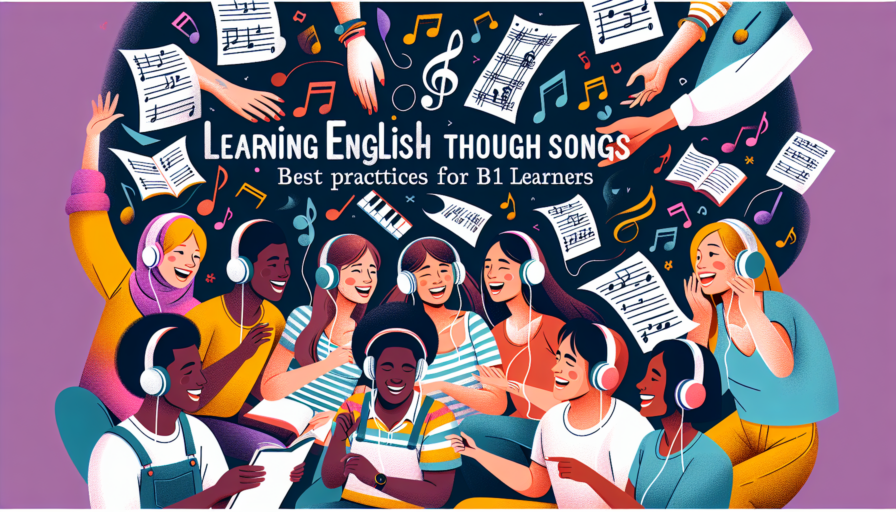1. Why Learning English Through Songs is Effective for B1 Learners
Learning English through songs is not only enjoyable but also a highly effective method for B1 learners. This approach leverages the natural rhythm, melody, and repetition found in music, making language acquisition more engaging and memorable. When B1 learners enjoy a song, they are more likely to absorb the vocabulary and grammatical structures presented, enhancing their overall fluency.
One key reason this method is effective is song lyrics. Lyrics often contain conversational language, idiomatic expressions, and cultural references that are essential for mastering English. As B1 learners sing along or read the lyrics, they actively participate in the learning process, allowing them to:
- Improve pronunciation
- Expand vocabulary
- Enhance listening skills
Additionally, the emotional connection that songs create can significantly boost motivation and drive. When B1 learners engage with music they love, they are more inclined to practice and revisit the material, resulting in better retention of the language. Through repetitive listening and singing, they can internalize the structure and rhythm of English, making it easier to apply in real-life conversations.
2. Top Songs for B1 Learners to Enhance Vocabulary and Grammar
Listening to music is a powerful and engaging way for B1 learners to enhance their vocabulary and grammar skills. The following sections outline some of the top songs that are not only enjoyable to listen to but also rich in linguistic content. By integrating these songs into your study routine, you can improve your language proficiency while having fun.
Here are some recommended songs that can help B1 learners:
- “Count on Me” by Bruno Mars – This upbeat track uses simple vocabulary and clear grammar, making it easy to understand and learn from.
- “Let It Be” by The Beatles – A classic song, it contains repetitive phrases and straightforward language that can help reinforce key vocabulary.
- “Firework” by Katy Perry – This empowering song features vivid imagery and a strong message, providing opportunities to learn descriptive adjectives and expressions.
- “Shake It Off” by Taylor Swift – With its catchy chorus and simple lyrics, this song encourages learners to focus on verb forms and informal expressions.
When listening to these songs, B1 learners should pay attention to both the lyrics and the underlying structures of the language. This not only aids in vocabulary acquisition but also strengthens grammatical understanding, making your learning experience both effective and enjoyable.
3. Best Practices for Incorporating Songs into Your English Learning Routine
Incorporating songs into your English learning routine can significantly enhance your language skills. Here are some best practices to maximize your learning experience:
- Choose the Right Songs: Opt for songs with clear lyrics and simple vocabulary. Genres like pop, folk, and children’s music often feature repetitive structures, making them easier to understand and memorize.
- Listen Actively: Engage with the music by reading along with the lyrics. This practice helps reinforce your understanding of vocabulary and sentence structure while improving your listening skills.
- Use Lyrics for Study: Break down the lyrics to study new words and phrases. Create flashcards or a vocabulary journal based on your favorite songs to enhance word retention.
- Singing Along: Practice pronunciation and intonation by singing along with the songs. This technique not only boosts your speaking skills but also improves your confidence in using the English language.
By following these best practices, you can effectively incorporate songs into your English learning routine, making the process enjoyable and fruitful.
4. Engaging Activities to Supplement Learning English Through Songs
Incorporating learning English through songs can be both fun and educational. Engaging activities not only enhance language acquisition but also make the process enjoyable. Here are several creative ways to supplement your English learning experience:
- Song Lyrics Gap Fill: Provide students with the lyrics of a song with certain words removed. Ask them to listen and fill in the blanks, enhancing their listening comprehension and vocabulary.
- Role Play: After analyzing a song, students can perform a short skit based on its themes or narratives. This encourages speaking practice and contextual understanding of the language.
- Music Video Creation: Encourage learners to produce their own music video by interpreting a song. This activity nurtures creative expressions while reinforcing language skills like writing and speaking.
- Lyric Translation: Ask students to translate the song’s lyrics into their native language and then back to English. This task promotes deeper understanding of vocabulary and idiomatic expressions.
These engaging activities are perfect supplements when learning English through songs. By integrating music with interactive tasks, learners can improve their language skills while having a great time.
5. Overcoming Challenges: How to Stay Motivated While Learning English Through Music
Learning a new language can be filled with challenges, but learning English through music offers a unique way to stay motivated. Engaging with songs can significantly enhance your listening skills, vocabulary, and pronunciation. Here are some effective strategies to maintain your enthusiasm throughout your journey:
- Create a Playlist: Curate a selection of your favorite English songs. This not only makes learning enjoyable but also helps you associate language with emotions and experiences.
- Set Goals: Establish achievable milestones, such as learning a new song each week or translating lyrics. This will give you a sense of accomplishment and keep you focused.
- Join a Community: Connect with others who are also learning English through music. Sharing insights and experiences can provide support and motivation, making the learning process more engaging.
- Incorporate Movement: Dance or sing along to your favorite tracks. This physical engagement can enhance memory retention and make the learning experience more enjoyable.
By employing these techniques, you can effectively navigate the obstacles of language acquisition. Emphasizing the fun and interactive aspects of learning English through music will keep you motivated, allowing you to enjoy the journey of mastering a new language.
